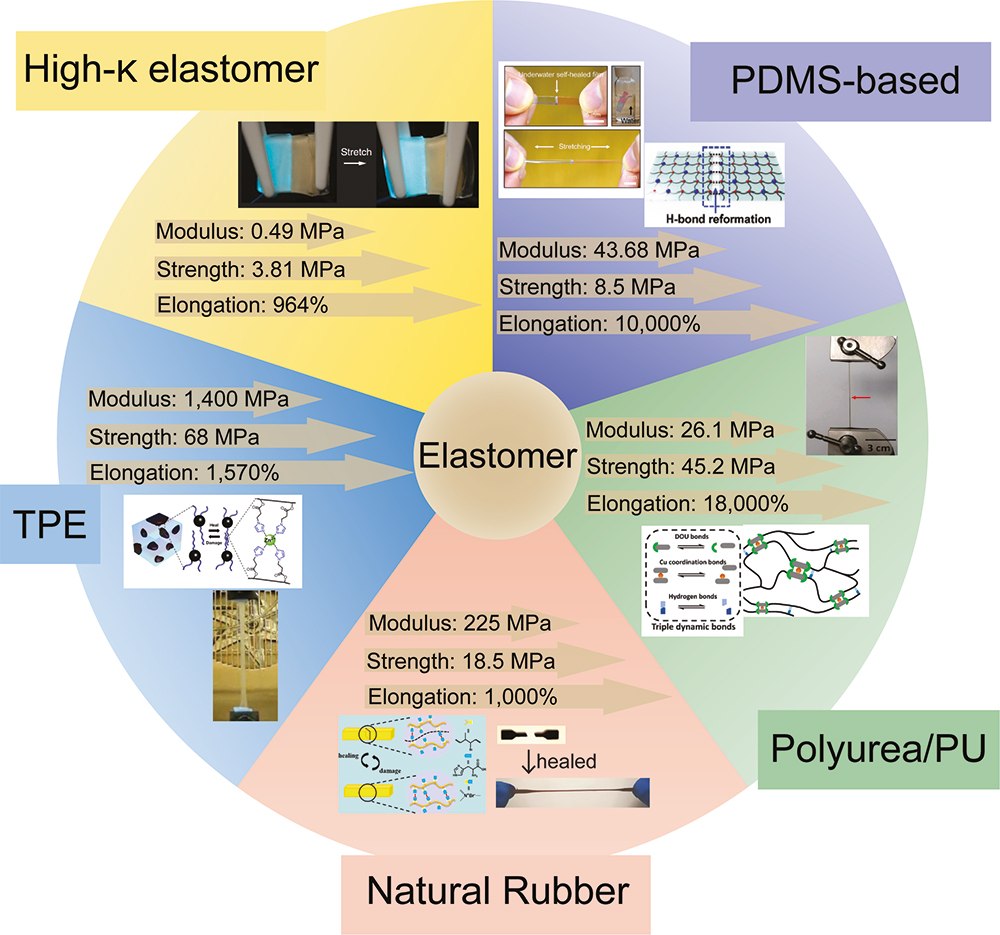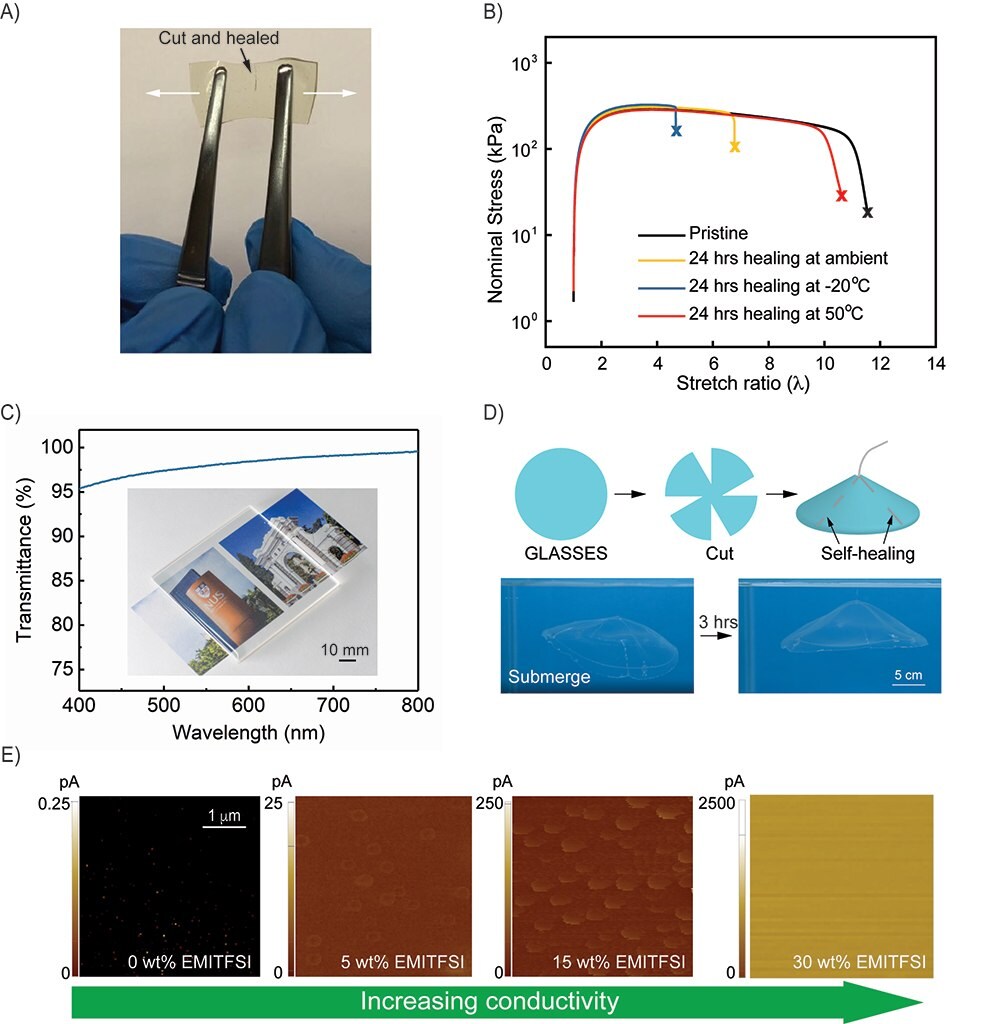Recent Trends in Self-Healing Soft Electronics
Yu Jun Tan<sup>1</sup>, Benjamin C. K. Tee<sup>2</sup>
1 Mechanical Engineering, National University of Singapore, 2Materials Science and Engineering, National University of Singapore
Material Matters™, 2021, 16.3 | Material Matters™ Publications
Introduction
Self-healing materials, inspired by biological systems, are capable of restoring some or most of their original properties when damaged without increasing their original mass.1,2 These state-of-the-art synthetic materials can be designed to self-recover from damages such as cuts, cracks, punctures, and impacts, either physically or chemically. Research shows these robust materials have the potential to extend the functional lifetime of materials and better ensure safety in the autonomous operations of electronics and machines.3
The healing efficiency, of the property of interest (P) of a self-healing material is quantifiable by:

Where P can be mechanical, electrical, optical, or other properties.4 Compared to other self-healing materials, like metals and ceramics,the healing efficiency of self‐healing polymers (SHPs) is superior, due to the high mobility of their polymeric chains. SHPs can be grouped according to three broad categories (Figure 1): inclusion of external healing agents, independence in self-healing activities, and class of polymers.

Figure 1.SHPs can be grouped according to three categories: inclusion of external healing agents: Intrinsic versus extrinsic SHPs; independence in self-healing activities: autonomic versus non-autonomic SHPs; type of polymers: thermosets, composites, covalent adaptable networks (CANs), or thermoplastics. The intrinsic SHPs are soft polymers, while the extrinsic SHPs are hard and strong polymers.
While autonomic SHPs restore their properties without external intervention in a self-contained manner, non-autonomic SHPs heal upon activation by specific external triggers such as thermal or chemical stimuli. The healing system in biomimetic autonomic SHPs is self-triggered once damage occurs, removing the need for exposure to external triggers. Some materials require gentle pressure to close up a wound for their autonomic self-healing and are considered in-between autonomic and non-autonomic self-healing.
SHPs can heal either extrinsically or intrinsically. Extrinsic SHPs contain and utilize external healing agents, which can make integration of the healing agents complex. On the other hand, intrinsic SHPs initiate repair without relying on external healing materials and systems. Self-repair is achievable via the strong reversibility of molecular interactions within the intrinsic SHPs.
There are four classes of SHPs based upon polymer type.1 Thermosets are insoluble and highly thermal stable, and usually require external healing agents to self-heal. For example, healing agents encapsulated in microcapsules or vascular systems rupture upon damage to release their payload. Polymers with covalent adaptable networks (CANs) or dynamic covalent bonds are thermosets with dynamic properties when triggered. CANs typically self-heal intrinsically but require external triggers.5 Non-covalent thermoplastics gain their strength from polymer chain entanglement and physical cross-linking. The self‐healing mechanisms for thermoplastics can be intermolecular diffusion and intermolecular forces such as H‐bond, dipole-dipole,6 van der Waals,7 ionic interactions,9 and coordination bonds,8 with or without external stimuli. Meanwhile, composite SHPs can be a physical blend of thermosets and thermoplastics or utilize shape memory materials and nanomaterials in the polymer matrix for self-healing. This group of materials is an example of extrinsic SHPs that can self-heal autonomously or non-autonomously.

Figure 2.Examples of elastomeric SHPs. PDMS-based elastomer, polyurea/PU-based elastomer, natural rubber, thermoplastic elastomer (TPE), and high-κ elastomer. Values are extracted from references 9–18. Adapted with permission from reference 1, copyright 2020 Wiley‐VCH; reference 19, copyright 2018 Wiley‐VCH; reference 20, copyright 2019 Wiley‐VCH; reference 21, copyright 2020 Elsevier; reference 22, copyright 2014 American Chemical Society; reference 23, copyright 2012 Springer Nature; and reference 6, copyright 2020 Springer Nature.
In the last decade, elastomeric SHPs (Figure 2) have been used to enhance the durability of organic electronic devices (Figure 3) such as touch and pressure sensors,24–26 light-emitting devices,6 nanogenerators,27 and energy storage devices.28 Inspiration for the design of these self-healing technologies comes from the remarkable healing ability of human skin,29 where catastrophic failure or fatigue in the synthetic materials can be self-repaired. Smart functional materials are a critical component of self-healing electronics.

Figure 3.A-B) Photographs of self-healing pressure sensors. C), Images of a self-healing triboelectric nanogenerator. Adapted with permission from reference 24, copyright 2012 Springer Nature; reference 25 copyright 2019 Springer Nature; and reference 27, copyright 2020 American Chemical Society.
PVDF-based Self-healing Polymers and Their Applications
Self‐Healing Dielectric Materials
A transparent, self‐healing, stretchable PVDF-HFP-based dielectric with high permittivity (high‐κ) was developed with permittivity values of 10 to 27, varying with frequency up to 105 Hz (Figure 4A).6 The amorphous PVDF-HFP-based self-healing dielectric material has a low glass transition temperature of −25 °C affording high mobility to the polymer chains at room temperature. The strong yet reversible physical interactions within the SHP are due to hydrogen-fluorine intermolecular bond pairing, such as the strong dipole-dipole and van der Waals interactions, allowing the SHP to repeatedly self-heal.
The SHP is not sticky on its surface but is an intrinsic, autonomous self-healing thermoplastic with rapid self-healing. The healing efficiency, η, was 91% after 5 minutes of healing at room temperature, with near-complete healing in 24h when mildly heated to 50 °C. The material can also self-heal at temperatures as low as −20 °C due to the low glass transition temperature (Figure 4B).
This supramolecular dielectric polymer can be stretched elastically up to 20% and deformed plastically to ~900%. With an ultimate tensile strength of 1.03 ± 0.02 MPa. Further enhancement of the elasticity of the polymer occurs via chemical cross-linking.6,32 Underwater self-healing can also occur by selecting polar hydrophobic small molecules that are miscible with the PVDF-HFP-based polymers.33
Self‐Healing Ionic Conductors
Transparent, ionically conductive PVDF-HFP-based polymers that can autonomously self‐heal underwater can also be designed (Figure 4C,D).25,34 Self‐healing happens via the highly reversible ion-dipole interaction between the ions and the polar fluorine molecules in the PVDF-HFP.
Unlike conventional electronic conduction, mobile ions drift from one end to another in ionic conduction systems while generating electrical conductivity. The ionic conductivity in this material system is tunable. Conductive atomic force microscopy (AFM) showed the change from discrete conductive droplets to a fully percolating phase in the ionic conductor when the concentration of the ions increased in the polymer matrix (Figure 4E).
It is crucial to develop self-healing conductors that quickly and effectively restore conductivity after damage and healing events. The ionic conductive PVDF-HFP-based polymer self-heals electrically when two halves of damaged interfaces are placed back together upon slight contact.9 After 10 times cutting and healing, the polymer’s healing efficiency in terms of conductivity was 90.7%. The mechanical self-healing efficiency in toughness was ~44% and ~99% after 1 day of healing under room temperature conditions and 50 °C.
When carefully paired between the ions and the base polymer, the self-healing ionic conductor has high transparency due to its strong intermolecular bonding.25,35,36 Moreover, submerging the hydrophobic ionic conductors in water does not change the appearance and electromechanical properties. The material self-heals when submerged in water, seawater, and acidic or basic solutions. The selected ions have high hydrophobicity that synergistically shielded themselves against the water molecules. As a result, these SHPs have comprehensive properties: high transparency, stability, stretchability, conductivity, hydrophobicity, and self‐healing.

Figure 4.A) Photograph of a self-healing high-κ dielectric material. B) Graph showing self-healing in mechanical properties of the high-κ dielectric material at −20 °C, room temperature and 50 °C. C) Transmittance spectrum of a self-healing ionic conductor over the visible wavelengths of 400–800 nm. Inset: photograph of the polymer film on a glass slide. D) Photographs show self-healed ionic conductors after submerging in water for 3 hours. The material retained its shape, self-healing capability, and transparency. E) Conductive AFM results show the transition from insulating to a percolating phase of ions in the PVDF-HFP-based polymer network. Adapted with permission from reference 6, copyright 2020 Springer Nature and reference 25, copyright 2019 Springer Nature.
Self-healing Devices Based on Transparent SHPs
SHPs with high healing efficiencies have numerous applications in soft electronics. Crucially, polymers that are highly stable, like the previously mentioned dielectric6 and ionic conductive25 materials, are attractive for use in high-tech applications instead of self-healing polymers that can change their forms and properties over time.
Transparent SHPs have found application in various electronics and machines, especially in stretchable and self‐healing touch screens and display screens. A highly transparent and stretchable capacitive touch screen that can self‐heal autonomously was produced using ionically conductive materials;25 the touch screen can even function and heal in water. The high transparency of the device allows for visible and infrared light communication through the material. A transparent, soft, and self-healing printed circuit board (PCB) was 3D printed using the SHPs (Figure 5A–C).
Healable, low‐field illuminating optoelectronic stretchable (HELIOS) light‐emitting capacitors (LEC) have also been fabricated (Figure 5D,E).6,37 High transparency and high‐κ dielectric material allows the HELIOS device to turn on at a much lower field and frequency. Most importantly, the capacitor is entirely self‐healable from cuts and punctures (Figure 5F–H), and capable of restoring luminance within 5 min. The ability to self-heal from punctures during operation is in part due to its low operating fields and frequencies. In sharp contrast, a LEC made from a control elastomer requires operation at more typical higher field and frequency, and a prototype underwent dielectric breakdown when operated at these more typical operating conditions.

Figure 5.Photographs of self‐healing displays. A) Schematic showing 3D printing of self‐healing transparent PCBs with LEDs embedded. B) The conformable, soft, and transparent PCB can work underwater, and C) can recover from severe damages. D) HELIOS LEC device can be reconfigured by healing across blue and orange devices. E) HELIOS LEC can be stretched to 800% while illuminating. F) Photographs showing the HELIOS device can self-recover from severe cuts through all three layers of the LEC device. G) The HELIOS device could remain illuminated when puncturing with insulating or conducting sharp objects, while the control elastomeric LEC device sparked at the perforation point due to dielectric breakdown. H) Photograph showing HELIOS device embedded in a soft robot survived and healed from punctures. Adapted with permission from reference 1, copyright 2020 Wiley‐VCH;reference 6, copyright 2020 Springer Nature; and reference 25, copyright 2019 Springer Nature.
Summary
The emergence of smart, functional SHPs will be highly beneficial to the advancement of the next-generation self-healing soft electronic devices. Inspired by nature, SHPs demonstrate exciting opportunities for more reliable devices with utility in autonomous operations,38,39 especially in unpredictable working environments like the deep sea, internal body, or outer space. Autonomously self-healing devices could help to minimize the need for repair or replacement of electronics and machines, potentially reducing the cost of materials and reducing electronic waste. However, in the quest for bioinspired self-healing soft electronics and machines, smart, functional SHPs that are strong, compliant, stretchable, biocompatible, and self-healing at various length scales are still in high demand.
References
Para seguir leyendo, inicie sesión o cree una cuenta.
¿No tiene una cuenta?